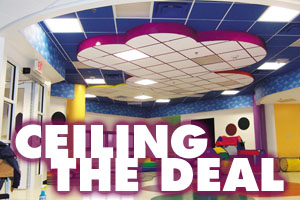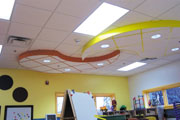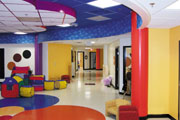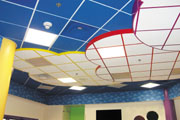

“We designed and laid out the ceiling with a detailed effect to give it depth and colors to make the kids feel like they’re outside,” explains Stephen Vecchi, senior project architect of Wolf Wineman, of Farmington Hills, Mich.
The entire project, which took less than five months, is also a very strong example of trades working in harmony, especially essential when time and money are quite finite.

Look up
The Bloomin’ Kids project serves a twofold purpose: to offer a place parents can send their children to ease the transition from preschool to elementary school, and to offer members of the community a positive look at what public schools can offer their children.“The basis for this preschool is to address multiple intelligences,” says John Stoner, owner’s rep with Bloomfield Hills schools. “The interiors need to address that the kids will be divided up and taught different things in different aspects.”
The needs of the children were in the forefront of the design.
“The ceiling design is based more on aesthetic than anything else,” Vecchi adds. “It was a little more expensive but we feel the cost was justified.”
Wolf Wineman has designers who specialize in interiors that appeal to kids. The ceiling components, consisting of USG’s Compasso grid, utilized 11⁄2-inch Halcyon tile with high NRC for sound absorption.
The grid and clouds of the ceiling are hung 1 foot down from the main ceiling. There are panels in the grid work, allowing one to see the layers of clouds and the different colors, an aesthetic difference that is actually more functional for getting lights into the grid.
“When we design a space for children, we want to make it playful and comfortable,” says Vecchi. “This includes lower windows so the kids can see outside. They need to feel at home.”
The ceiling was originally specified with a revealed edge tile in the clouds. But this being 11⁄2-inch-thick insulation with a laminated mat and fabric face, a yellow line was visible all the around the edges. To avoid that in open areas, the design was changed to a square-edge tile; something changed during actual construction.

Public works
Due to the tight schedule and budget, all the trades worked effectively in a small space in a short amount of time. The George W. Auch Co., of Pontiac, Mich., managed the project.“We were contracted by the owners to manage the project,” explains Chris Jones, project engineer. “After reviewing the conceptual documents from Wolf Wineman, we assembled a budget that gave the owner the approximate cost of the building. The project was then put into full design and then put out for public bid.
With an agreed-upon budget in place, the practical aspects of the project were addressed. Metal framing was specified for the building to save time and money, utilizing studs manufactured by Dale Incor.
“Metal framing saved time because we were able to order the product quickly and it didn’t require an extensive design,” says Jeff Hamilton, the project manager from George W. Auch Co. “The stud manufacturer was able to calculate the structural concerns faster and the erection went up much faster than steel- or masonry-bearing construction. Metal also simplified the foundation design because we were able to pour the whole foundation and slab before we put anything in the air.”
George W. Auch Co. and Wolf Wineman were under pressure to get the job on paper quickly. The job was tightly budgeted, but at the time of this writing, it was complete and under budget.
“The architect attended all the biweekly meetings and worked in the field to help solve any problems,” Hamilton adds. “By making himself available, the architect was always on hand to explain how something would look and what detailing was needed to make that happen. Everyone had an open mind because good ideas are always welcome.”
The major challenge for ACP in terms of the ceiling design was taking Wolf Wineman’s drawings, getting them into shop drawing fashion from the manufacturer, making sure they were all what was asked for and then constructing them to look good for the end user. Acoustical Ceiling & Partition Co. Inc., of Ann Arbor, Mich., sent the drawings to the manufacturer, which is sent back as shop drawings to verify the measurements. The manufacturer makes the shapes but everything is assembled in the field.
“With the owner highly involved, the owner got to make sure everything matched Wolf Wineman’s designs,” Hamilton adds.
Did such a colorful design cause any discrepancy between architects’ imaginings and contractors’ realities?
“We were lucky enough to work with George W. Auch Co. and get them on board early,” Vecchi says, illustrating a positive example of management and architect teamwork adding up to a successful project. W&C

Report Abusive Comment